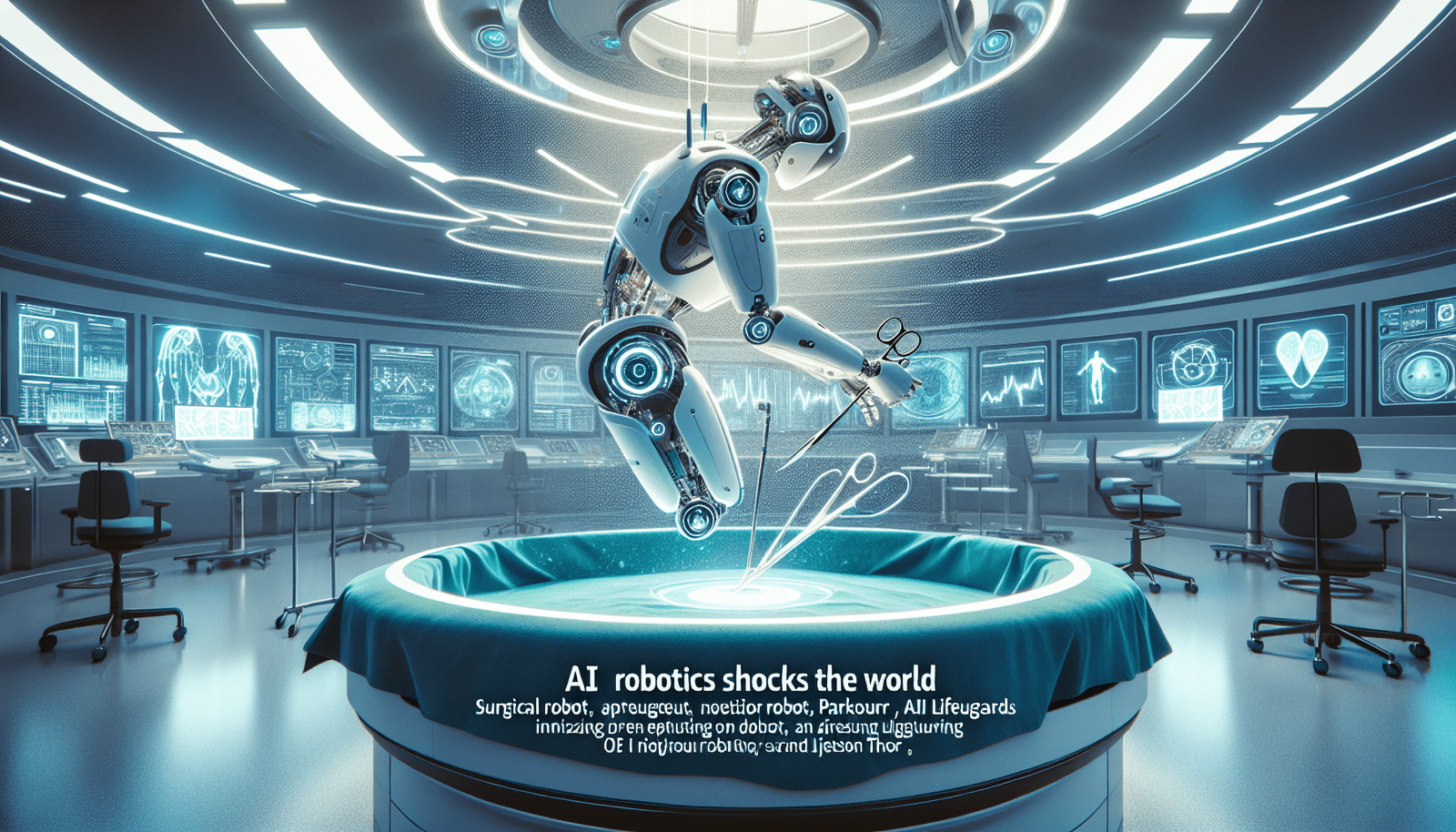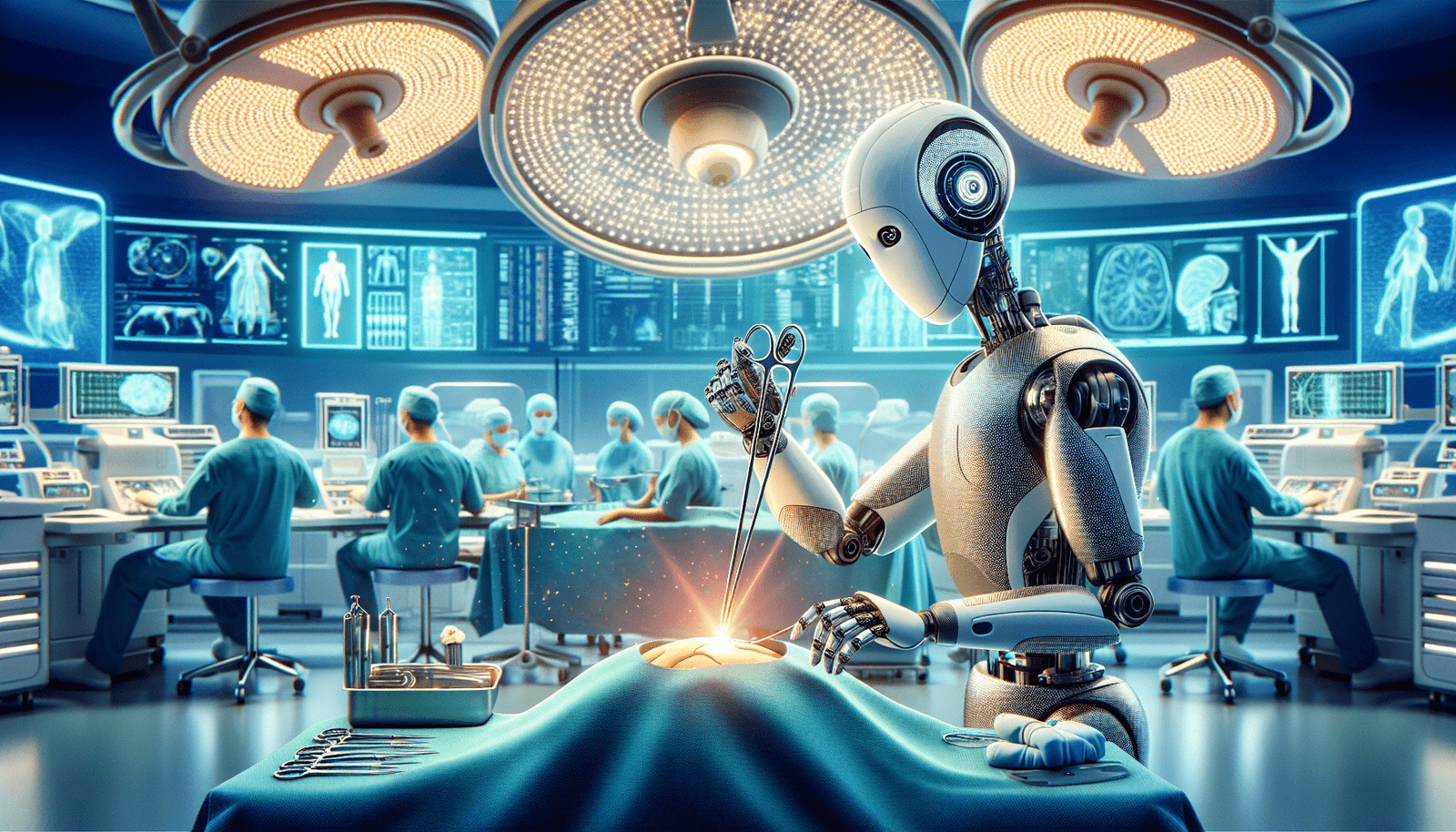As the world continues to be astonished by technological innovation, the latest advancements in AI robotics reveal a future where machines can match, and sometimes exceed, human capabilities across various fields. Recent developments showcase impressive feats: robotic canines mastering parkour, humanoid robots such as Digit reshaping logistics, and surgical robots at Johns Hopkins University executing critical tasks with unmatched precision. These breakthroughs signify a paradigm shift in how industries operate, delivering a new level of efficiency and adaptability.
Moreover, AI’s expanding role in different sectors is clearly visible, from AI lifeguards that revolutionize water safety in California and China, to autonomous chemistry bots at the University of Liverpool conducting experiments at an unprecedented pace. Additionally, artificial intelligence has made extravagant inroads into the art world with impressive auction sales of AI-generated works. As Nvidia prepares to launch the Jetson Thor platform by early 2025, the stage is set for AI-powered robotics to redefine human interactions and expand the boundaries of what’s possible.
Advancements in AI Robotics
Overview of Recent Breakthroughs
In the realm of AI robotics, recent advancements have been nothing short of revolutionary. Groundbreaking innovations abound, such as robot dogs mastering parkour, humanoid robots transforming the logistics sector, and surgical robots performing intricate procedures with unprecedented precision. These developments are a testament to the rapid progression of robotics technology, fueled by enhancements in artificial intelligence and machine learning capabilities. Generative AI is instrumental in training robots for complex tasks in highly realistic virtual environments, leading to improved navigation and efficiency in real-world applications.
The Impact of Robotics Advancements on Society
The swift advancement of robotics technology has significant implications for society at large. These technologies are set to revolutionize various industries, from healthcare and logistics to public safety and the arts. They promise to increase efficiency, reduce human error, and open new avenues for problem-solving on a global scale. However, the integration of AI robotics also calls for careful consideration of ethical and societal impacts, including workforce displacement and privacy concerns. Responsible implementation and regulation are crucial to maximizing benefits while minimizing potential drawbacks.
Examples of Cutting-edge Robots
Some examples of cutting-edge robots that epitomize current advancements include robotic systems like the Da Vinci surgical robot, humanoid logisticians like Digit, and energy-efficient lifeguard drones. Each of these systems represents a leap forward in their respective fields, showcasing the diverse applications of AI robotics—from healthcare precision and operational efficiency to enhanced safety measures.
Surgical Robots
Introduction to Surgical Robotics
Surgical robotics has emerged as a cornerstone of modern medical technology, leveraging AI to deliver patient care with a degree of accuracy and consistency once thought impossible. Surgical robots assist in performing delicate procedures, offering enhanced visualization, precision, and control compared to traditional methods. As these systems continue to evolve, they are poised to transform surgical practices worldwide.
Case Study: Da Vinci Surgical System at Johns Hopkins University
The Da Vinci surgical system is a prime example of innovation in surgical robotics. At Johns Hopkins University, this system is employed for a range of procedures, utilizing imitation learning techniques to enhance its capabilities. By analyzing thousands of surgical videos, the robot learns critical tasks such as stitching and tissue handling with human-like adeptness. This approach not only reduces the need for manual programming but also allows for adaptive operations, setting a new standard for surgical interventions.
Imitation Learning in Surgical Robotics
Imitation learning has become a pivotal component in advancing surgical robotics. By observing and replicating human actions, surgical robots can perform complex tasks with a high success rate, improving patient outcomes. This method enables robots to learn autonomously from human inputs, adopting best practices and minimizing potential errors. Such technological integration is instrumental in creating surgical systems that can potentially perform entire procedures independently.
Benefits of Surgical Robots in Healthcare
The integration of surgical robots in healthcare offers numerous advantages. They provide enhanced precision, leading to reduced risk of complications and better recovery times for patients. The ability to perform minimally invasive surgeries translates to shorter hospital stays and lower healthcare costs. Furthermore, surgical robots can mitigate the shortage of skilled surgeons by delivering high-quality care in underserved areas, democratizing access to advanced medical procedures.

This image is property of i.ytimg.com.
Mastering Parkour: Robot Dogs
Development of Parkour Capabilities in Robot Dogs
The concept of robot dogs mastering parkour highlights the strides made in robotic agility and mobility. Researchers have utilized generative AI to train these robots to navigate complex environments by simulating real-world conditions. This training enables robot dogs to perform dynamic tasks like climbing obstacles and maintaining balance while navigating diverse terrains—capabilities critical for potential real-world applications.
Technical Challenges and Solutions
Developing parkour-capable robots presents multiple technical challenges, such as balancing energy efficiency with physical dexterity. Solutions involve sophisticated algorithms that emulate physical dynamics, improved actuator systems for enhanced movement, and advanced sensory inputs to adapt to various scenarios. These innovations ensure that robot dogs can perform with agility comparable to biological organisms.
Implications for Agility and Mobility in Robotics
Such advancements signify a monumental leap in the field of robotics, showcasing the potential for creating machines that can traverse environments typically inaccessible to traditional robots. This capability opens new possibilities in search and rescue missions, environmental monitoring, and even space exploration, where robots could scavenge terrains fraught with obstacles and unpredictable conditions.
Robotics in Logistics
Humanoid Robot Digit: An Introduction
Digit, a humanoid robot developed by Agility Robotics, exemplifies the application of AI robotics in the logistics sector. Designed to work alongside humans, Digit is engineered for adaptability in various environments, possessing the versatility to handle a wide array of tasks. This humanoid robot represents the forefront of efficiency optimization in warehouse and manufacturing operations.
Applications in Logistics and Manufacturing
Digit’s design enables it to undertake demanding logistical and manufacturing roles, such as sorting, lifting, and transporting items. Its ability to navigate uneven surfaces and operate in constrained spaces highlights its adaptability and functional breadth. Industries are increasingly employing robots like Digit to enhance operational efficiency, reduce human workload, and support the execution of repetitive or hazardous tasks.
Navigating Complex Environments
One of Digit’s standout features is its capacity to navigate complex environments autonomously. Equipped with advanced sensors and an AI-driven control system, Digit can maneuver through challenging pathways and adapt to unforeseen changes in its surroundings. This capability not only bolsters its effectiveness in traditional logistical duties but also sets the stage for future roles requiring even greater environmental adaptability.

AI Lifeguards and Drones
Deployment in China and California
AI lifeguards, powered by drones and AI algorithms, are being deployed in regions such as China and California to bolster water safety. These systems provide constant surveillance and swift incident response, representing a merger of AI and public safety technologies.
Technological Features of AI Lifeguards
AI lifeguards incorporate state-of-the-art technology, including AI-powered surveillance cameras, life-saving buoys, and rapid response mechanisms. The integration of machine learning allows for real-time analysis of environmental data, improving capabilities in detecting and acting upon potential threats.
Improving Water Safety and Rapid Incident Response
The deployment of AI lifeguards significantly enhances the ability to maintain safety in aquatic environments. Providing continuous coverage and automated alerts, these systems allow for quicker responses to drowning incidents, potentially saving lives and preventing accidents in highly trafficked water areas.
AI in the Arts and Chemistry
AI-created Artwork Selling for Over $1 Million
AI’s foray into the arts world culminated in a historic sale where an AI-created artwork fetched over $1 million. This achievement underscores the burgeoning influence of AI on creative industries, challenging traditional perceptions of art and artist.
The Role of AI in the Art World
AI’s function in the art world extends beyond creation to include curation and restoration. AI technology is used to analyze art history, predict market trends, and even restore damaged works. This symbiotic relationship suggests a future where AI plays a central role alongside human artists and curators.
Autonomous Chemistry Bots at the University of Liverpool
Autonomous chemistry bots, such as those developed at the University of Liverpool, are pioneering a new era of automation in scientific research. These bots conduct experiments independently, efficiently performing tasks and analyzing results with minimal human intervention.
Revolutionizing Research Processes with AI
AI-driven chemistry bots revolutionize research by drastically reducing the time and resources needed for experimentation. These systems can autonomously generate hypotheses, conduct complex analyses, and adjust protocols on the fly, setting a new standard in chemical and materials research innovation.

Nvidia’s Jetson Thor
Introduction to Jetson Thor Platform
Nvidia is pushing the envelope in AI platforms with the introduction of Jetson Thor, a computing environment designed to enhance humanoid robot functionalities. This platform anticipates transformational contributions to human-computer interaction and autonomous behavior.
Expected Launch and Features
Set for launch in 2025, the Jetson Thor platform is expected to embody cutting-edge AI capabilities, including advanced computer vision and natural language processing. Such features will empower humanoid robots to navigate complex social and physical environments with minimal human guidance.
Enhancing Humanoid Robot Interactions
The Jetson Thor platform aims to revolutionize how humanoid robots interact with humans and environments. By integrating comprehensive AI technologies, these robots can smoothly collaborate with people across different contexts, potentially playing significant roles in caregiving, education, and customer service.
The Future of Humanoid Robots
Autonomous Interactions and Adaptability
The future of humanoid robots is characterized by autonomous interactions and heightened adaptability. Fueled by continuous advancements in AI, these robots will be capable of learning from environments and adjusting their behaviors in real time, offering significant flexibility and functionality.
Impacts on Human-Robot Collaboration
Humanoid robots are poised to transform human-robot collaboration. They offer the potential for co-working environments where robots and humans function side-by-side, each augmenting the abilities and productivity of the other. This relationship could redefine roles across industries and service sectors.
Ethical Considerations in Humanoid Robotics
As humanoid robots become more integrated into everyday life, ethical considerations come to the fore. Topics such as privacy, security, and the moral implications of autonomous decision-making require thorough discourse to establish guidelines that ensure responsible implementation and societal benefit.
Technological Impacts Across Fields
AI Robotics in Healthcare
In healthcare, AI robotics is making notable contributions by improving surgical accuracy, automating diagnostics, and enhancing patient care. These technologies alleviate pressure on healthcare systems and provide high-quality services across diverse settings.
Logistics and Manufacturing Transformations
The integration of robotics in logistics and manufacturing is transformative, leading to increased efficiency and reduced labor costs. Robots like Digit streamline operations and offer innovative solutions to traditional industry challenges.
Safety Improvements in Public Spaces
AI robotics significantly improve safety in public spaces through continuous monitoring and quick response capabilities. From AI lifeguards to surveillance drones, these technologies enhance public security and provide reassurance to communities.
Conclusion
Summary of AI Robotics Advancements
Recent advancements in AI robotics have demonstrated considerable potential across various fields. From surgical precision to logistics efficiency and enhanced safety measures, these technologies exhibit capabilities that surpass traditional methodologies, fostering new opportunities for development and innovation.
Potential Future Developments
The trajectory of AI robotics suggests a future rich with potential developments. Autonomous systems will continue to grow more intelligent and responsive, leading to profound transformations in interpersonal interactions, occupational practices, and lifestyle enhancements.
Long-term Societal Impact and Opportunities
The long-term impact of AI robotics on society offers exciting opportunities for global problem-solving and technological growth. By addressing challenges such as labor shortages, healthcare disparities, and safety concerns, these advancements can foster an improved quality of life and expanded human capabilities. Nonetheless, careful ethical considerations and strategic implementation efforts will be essential to realizing their full potential.